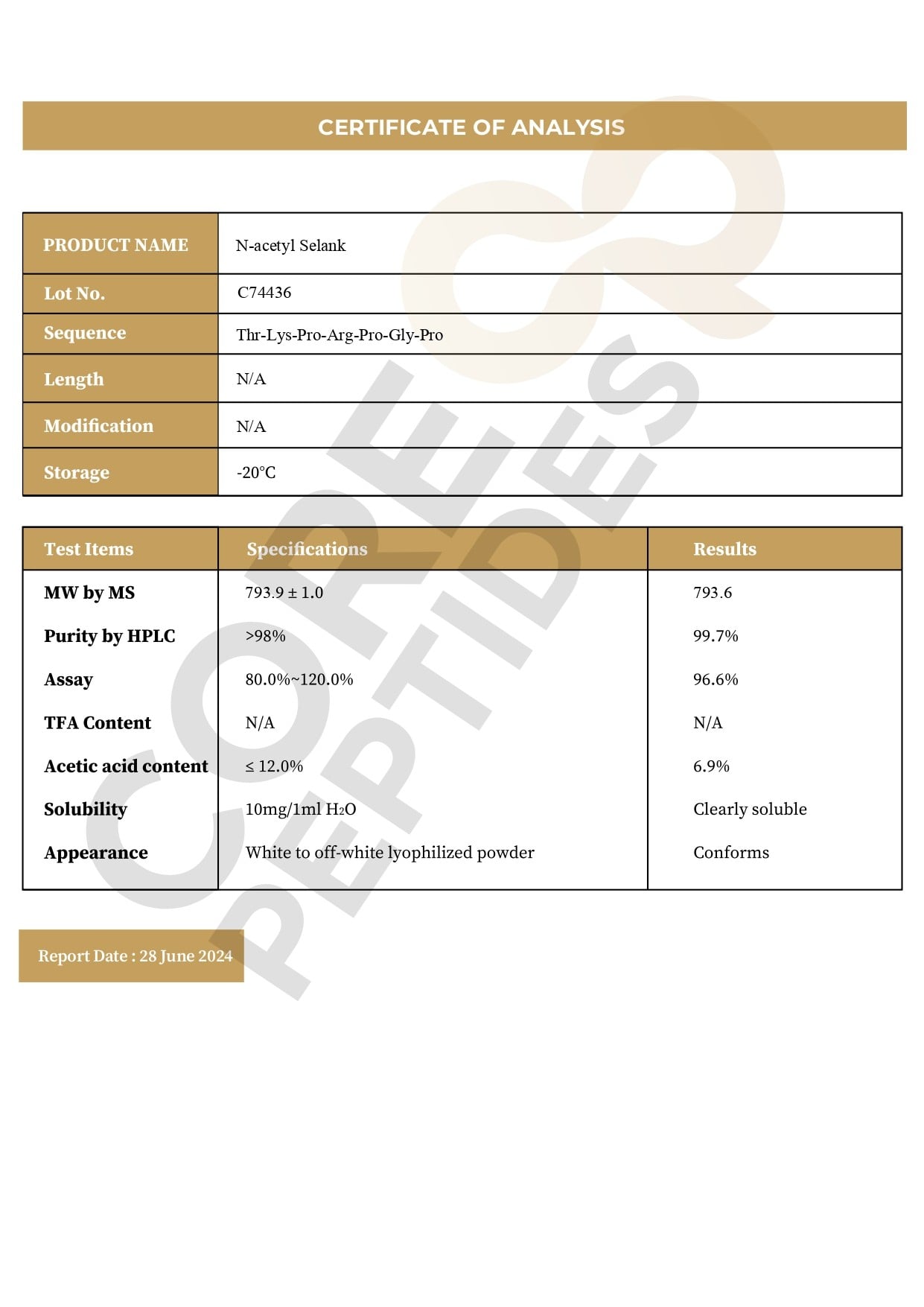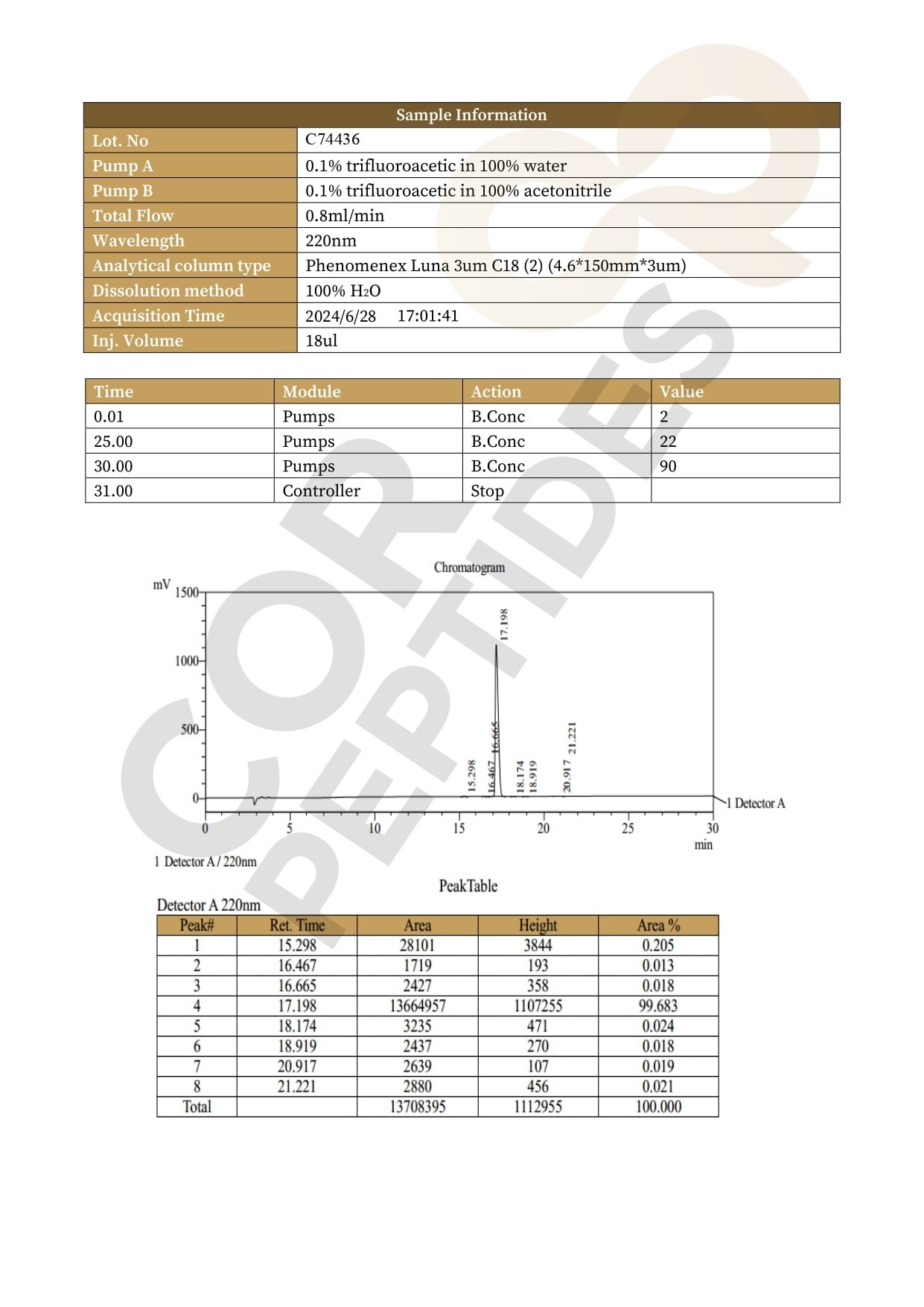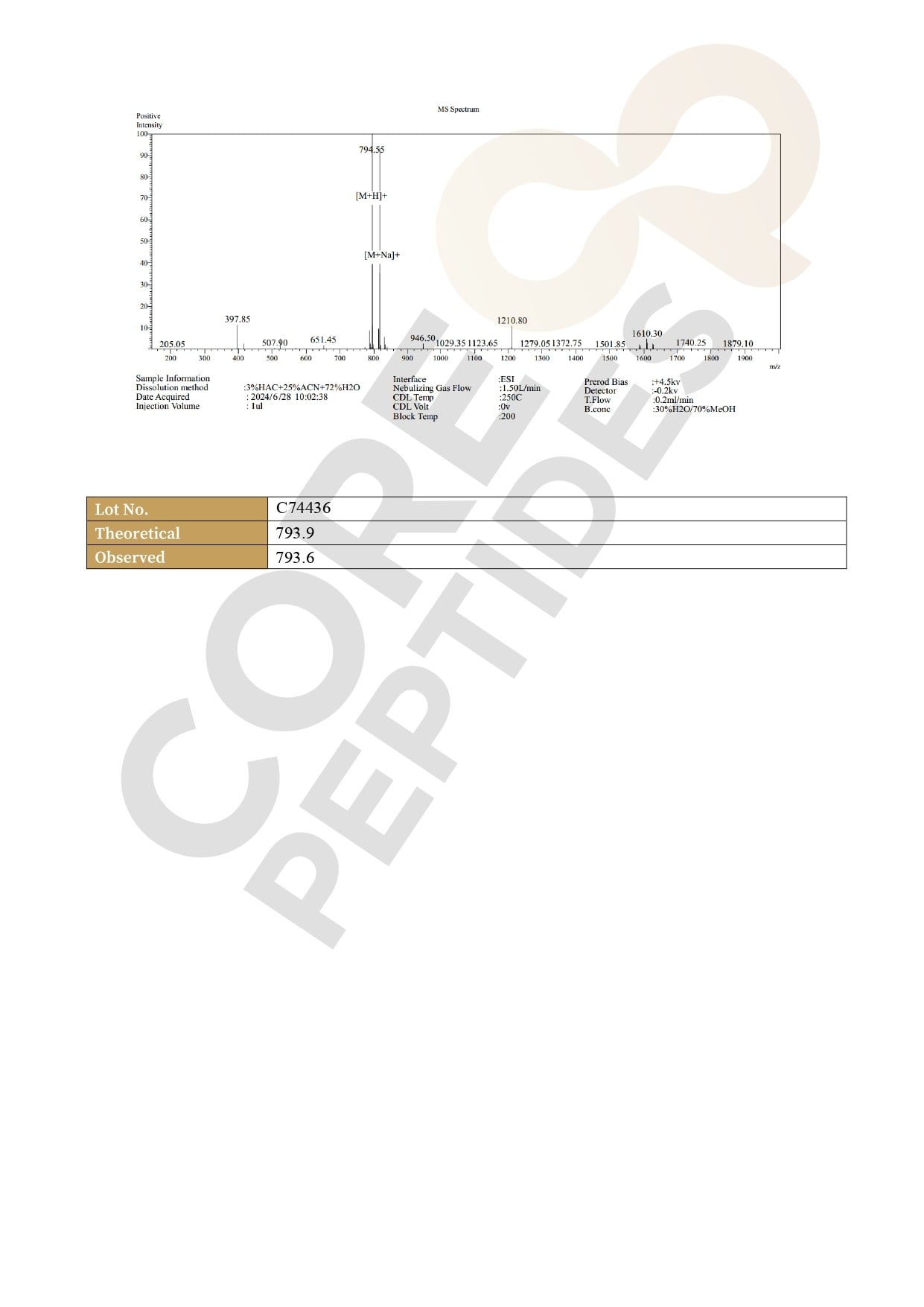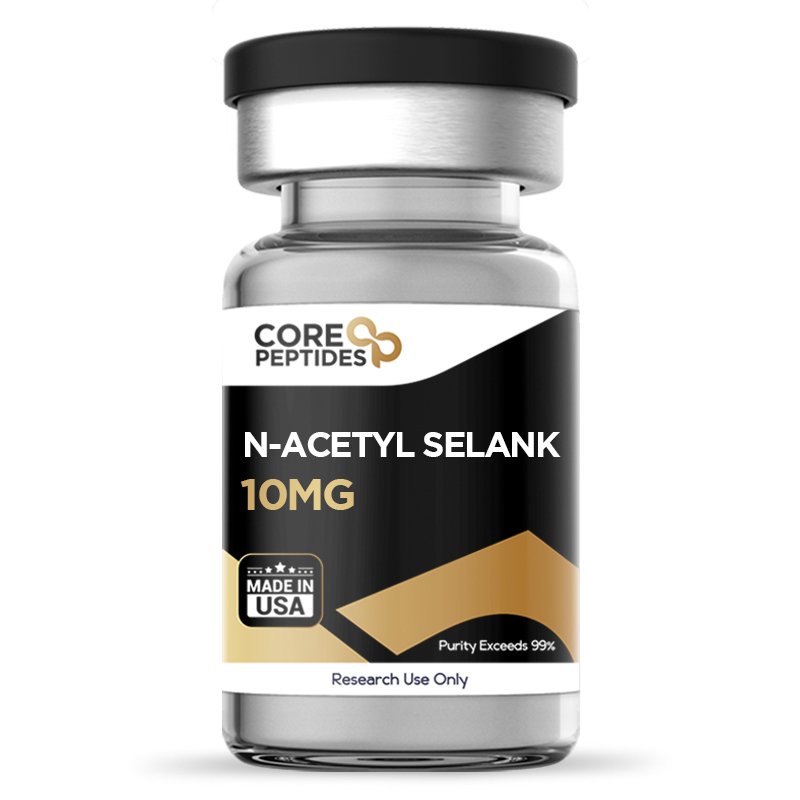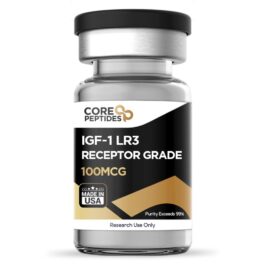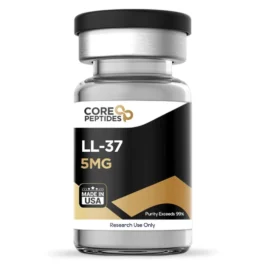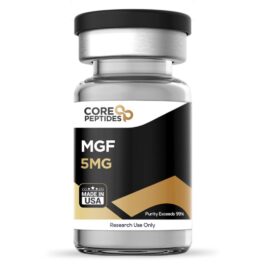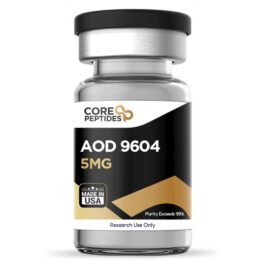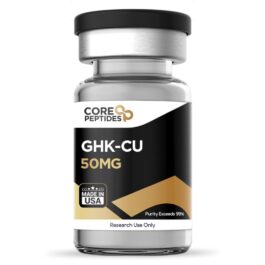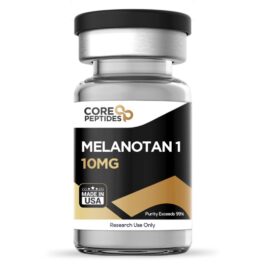N-Acetyl Selank (10mg)
$71.00
Size: 10mg
Contents: N-Acetyl Selank
Form: Lyophilized powder
Purity: >99%
SKU: N-Acetyl-Selank
FREE Shipping on $200+ orders
Discount per Quantity
| Quantity | Discount | Price |
|---|---|---|
| 5 - 8 | 5% | $67.45 |
| 9 + | 10% | $63.90 |
N-Acetyl Selank Peptide
N-Acetyl Selank is a short, synthetic heptapeptide analogous to the naturally occurring peptide called Tuftsin.(1) Tuftsin is an endogenous tetrapeptide that appears to regulate the immune system. Selank peptide may exhibit immunomodulatory potential; however, it has also been studied in models of anxiety and cognitive decline for its nootropic potential. Apart from the homology with tuftsin, the peptide appears to have a Pro-Gly-Pro fragment at its C-terminus, which may provide an enhancement of Selank's potential to traverse through different tissues and models including the blood-brain barrier (BBB). The BBB is a highly selective, semi-permeable border that separates the circulating blood from the tissues and extracellular fluid in the central nervous system, and is considered to play a crucial role in regulating the passage of substances. Pro-Gly-Pro addition might enhance BBB permeability by potentially impacting the peptide's overall hydrophilicity or lipophilicity, thereby increasing its affinity for the lipid-rich environment of the BBB. Additionally, the Pro-Gly-Pro sequence may interact with specific transport mechanisms or receptors at the BBB, potentially triggering a facilitated transport or receptor-mediated endocytosis. Such processes might allow Selank to bypass the tight junctions that normally restrict the passage of large molecules. Pro-Gly-Pro fragment may also influence the peptide's tertiary structure in a way that makes it more conducive to crossing the BBB.
Further, N-Acetyl Selank Amidate has an additional acetyl group attached to the N-terminus. Adding an acetyl group to the N-terminus in N-Acetyl Selank Amidate may improve the peptide's stability through several speculative mechanisms. Acetylation might potentially shield the peptide from rapid enzymatic degradation by exopeptidases, as it might make the N-terminus less accessible or recognizable to these enzymes. Additionally, acetylation may induce changes in the peptide's structure, possibly leading to a more stable conformation that resists denaturation.
Overview
Studies suggest that the Selank peptide produces possible action in several ways:
- Firstly, by potentially stimulating the gamma-aminobutyric acid (GABA) receptors system.(2) GABA is considered an inhibitory neurotransmitter in the brain, reducing neuronal excitability, promoting relaxation, and alleviating anxiety. Researchers have posited Selank to potentiate the capacity to induce changes in the expression of genes associated with GABA receptors, transporters, and ion channels. This implies that Selank might potentially influence GABAergic neurotransmission by modulating the availability or functionality of these key components. Furthermore, studies posit that Selank's actions may potentially extend beyond direct actions on GABA receptor gene expression to allosteric modulation of the GABAergic system. This is hinted at by the differential gene expression patterns observed following Selank and GABA exposure, wherein Selank appeared to have uniquely influenced the expression of certain genes. This nuanced action suggests that Selank may modulate the GABAergic system's function in a manner distinct from the straightforward receptor activation induced by GABA. Selank might also initiate longer-lasting alterations in neurotransmitter systems, potentially explaining its prolonged anxiolytic actions in experimental models.
- Secondly, the peptide may potentially interact with serotonin signaling.(3) Serotonin signaling in the brain is posited to regulate mood and anxiety. Experiments in murine models with blocked serotonin synthesis suggest that Selank may exert the potential to modulate serotonin levels under compromised serotonergic function. Selank was posited to enhance serotonin metabolism in the brainstem via a rapid onset of action on the serotonin system. Specifically, the peptide was suggested to promote increased metabolic activity of serotonin in parts of the brain linked to regulating mood and anxiety. Further, the study posits that Selank's potential to elevate serotonin metabolism indicates a possible mechanism through which Selank might correct disturbances associated with reduced serotonin function.
- Thirdly, the peptide may act by potentially modulating enkephalin signaling.(4)(5) Studies have posited that Selank may have an inhibitory action on enkephalin-degrading enzymes. This indicates that Selank might slow down the degradation of enkephalins. Enkephalins, as natural ligands of opioid receptors, are considered to play a role in pain perception and modulating mood and stress, implying that Selank’s action on these enzymes might enhance the availability of enkephalins, thereby potentially amplifying their actions. Studies also posit that there may be a tau(1/2) leu-enkephalin increase during Selank exposure in anxiety models.
- Finally, the peptide may potentially affect brain-derived neurotrophic factor (BDNF) expression.(8) Selank has been suggested to significantly elevate BDNF mRNA levels in the hippocampus, a part of the central nervous system. Selank's potential to enhance BDNF expression, especially in the context of stress and glucocorticoid-induced suppression of BDNF, points towards its potential research implications for ameliorating reduced neuroplasticity.
- Furthermore, researchers are currently investigating the potential actions of the peptide via genome expression and involvement in the inflammatory process.(7)
Chemical Makeup(8)
Molecular Formula: C33H57N11O9
Molecular Weight: 751.9 g/mol
Other known titles: TP-7, Selanc
Research and Clinical Studies
Unfortunately, research on N-Acetyl Selank in its acetylated form is still sparse. However, the peptide is expected to have similar impacts as its unacetylated counterpart, Selank, with the addition possibly only affecting the peptide by providing higher stability. Because of this lack of research data, we cite only Selank studies below.
N-Acetyl Selank and Anxiolytic Action
In 2008, a clinical study(5) was conducted on research models of generalized anxiety disorder (GAD). The research models were divided into two groups – half were presented with allopathic anxiety compounds, and the other half were presented with Selank peptide. After completing this study, the psychometric levels of all models were examined.
Based on the results, it was suggested that the Selank peptide appeared to be potentially as impactful as the control compound in reducing the models’ anxiety levels. The peptide-exposed group also exhibited reportedly positive psychostimulant reactions. As per A A Zozulia et al., “The clinical-biological study revealed that [models] with GAD and neurasthenia had the decreased level of tau(1/2) leu-enkephalin [...]. The increase of this parameter and stronger positive correlations with anxiety level were observed during the [exposure to] Selank.”
N-Acetyl Selank and Anxiety
In this clinical study,(9) research models of standard anxiety and phobia thresholds were examined. The research models were separated into an experimental and control group; the controls were exposed to an allopathic compound, and the experimental group was exposed to Selank peptide. After this study's completion, the results appeared to indicate the peptide's anxiolytic and nootropic potential.
N-Acetyl Selank and Mental Cognition
Research studies(10) evaluated experimental murine models following exposure to Selank peptide, after which the mice underwent ‘training’ exercises for four days to learn conditioned avoidance response (CAR). Observing the behavior of the models throughout the training period, researchers observed that the learning abilities of murine models appeared to improve as the number of errors reduced over time, compared to control models under the same conditions. These researchers suggested that the peptide may have exhibited nootropic potential. It is posited that such actions on learning and memory might involve several interconnected mechanisms, such as the modulation of neuropeptide systems in the brain, leveraging the potential role these peptides may play in cognitive functions to enhance learning and memory processes. Further, Selank may influence the neural pathways associated with memory consolidation, possibly improving synaptic stability and efficiency, deemed essential for learning. Selank might also facilitate cognitive performance indirectly by reducing anxiety-related parameters, which may often hinder learning efficiency, suggesting a role in the affective components of cognition. The peptide may also have the unique potential to enhance neural plasticity or resilience in underperforming cognitive circuits, thereby improving their functionality.
N-Acetyl Selank and Immunomodulation
Research models of anxiety and neurasthenia were evaluated in this study(11) following routine exposure to Selank for two weeks. After two weeks, blood samples were collected and analyzed. It was reported that there was a significant rise in the levels of interleukin-6 cytokines and alteration in the Th1 to Th2 cytokine ratio. As per O.N. Uchakina et al., "The cytokine regulating effects revealed in the study suggest that Selank [might act as] a novel immunomodulator in … anxiety-asthenic disorders. Additionally, the adaptogenic properties of Selank may benefit … environmental stressors to prevent infectious diseases.”
N-Acetyl Selank and Substance Withdrawal
A study(12) in experimental murine models infused the animals with 10% ethanol for 24 weeks. Upon discontinuing alcohol infusion, these murine models exhibited significant alcohol withdrawal symptoms. At this time, the peptide was then given to all affected murine models. 48 hours after the peptide, it was suggested by the researchers that the alcohol withdrawal symptoms were reportedly reduced in all murine models.
N-Acetyl Selank and Cholesterol Control
In one study,(13) murine models were subjected to a high-fat diet for six consecutive weeks until they gained a standard set weight. At that time, the models were divided into two groups – one exposed to a sodium chloride solution and the rest to the Selank peptide. Upon analysis, it was observed that the peptide group exhibited apparently improved fat metabolism, with a reported reduction of cholesterol levels up to 58%. Most notably, the researchers suggested that Selank may potentially decrease total cholesterol, low-density lipoprotein (LDL), very-low-density lipoprotein (VLDL) cholesterol, and triglycerides. This suggests Selank may have either a direct or indirect role in modulating lipid metabolism and may possibly exhibit hypocholesterolemic and/or hypolipidemic action. Furthermore, the study observed apparent improvements in hemostasis parameters, such as increased total fibrinolytic activity and a reduction in platelet aggregation, which might imply amelioration of prothrombotic states. The research also hints at a potential regulatory action of Selank on glucose homeostasis.
N-Acetyl Selank peptide is available for research and laboratory purposes only. Please review and adhere to our Terms and Conditions before ordering.
References
- Kozlovskaya MM, Kozlovskii II, Val'dman EA, Seredenin SB. Selank and short peptides of the tuftsin family in the regulation of adaptive behavior in stress. Neurosci Behav Physiol. 2003 Nov;33(9):853-60. https://pubmed.ncbi.nlm.nih.gov/14969422/
- Volkova, A., Shadrina, M., Kolomin, T., Andreeva, L., Limborska, S., Myasoedov, N., & Slominsky, P. (2016). Selank Administration Affects the Expression of Some Genes Involved in GABAergic Neurotransmission. Frontiers in pharmacology, 7, 31. https://www.ncbi.nlm.nih.gov/pmc/articles/PMC4757669/
- Semenova, T. P., kozlovskiĭ, I. I., Zakharova, N. M., & Kozlovskaia, M. M. (2009). Eksperimental'naia i klinicheskaia farmakologiia, 72(4), 6–8.
- Kost, N. V., Sokolov, O. I.u, Gabaeva, M. V., Grivennikov, I. A., Andreeva, L. A., Miasoedov, N. F., & Zozulia, A. A. (2001). Ingibiruiushchee deĭstvie semaksa i selanka na énkefalindegradiruiushchie fermenty syvorotki krovi cheloveka [Semax and selank inhibit the enkephalin-degrading enzymes from human serum]]. Bioorganicheskaia khimiia, 27(3), 180–183. https://doi.org/10.1023/a:1011373002885
- Zozulia, A. A., Neznamov, G. G., Siuniakov, T. S., Kost, N. V., Gabaeva, M. V., Sokolov, O. I.u, Serebriakova, E. V., Siranchieva, O. A., Andriushenko, A. V., Telesheva, E. S., Siuniakov, S. A., Smulevich, A. B., Miasoedov, N. F., & Seredenin, S. B. (2008). Zhurnal nevrologii i psikhiatrii imeni S.S. Korsakova, 108(4), 38–48.
- Inozemtseva, L. S., Karpenko, E. A., Dolotov, O. V., Levitskaya, N. G., Kamensky, A. A., Andreeva, L. A., & Grivennikov, I. A. (2008). Intranasal administration of the peptide Selank regulates BDNF expression in the rat hippocampus in vivo. Doklady biological sciences : proceedings of the Academy of Sciences of the USSR, Biological sciences sections, 421, 241–243. https://doi.org/10.1134/s0012496608040066
- T.A Kolomin et al., Transcriptomic Response of Rat Hippocampus and Spleen Cells to Single and Chronic Administration of the Peptide Selank. June 2, 2009.
- National Center for Biotechnology Information (2023). PubChem Compound Summary for CID 11765600, Selank. https://pubchem.ncbi.nlm.nih.gov/compound/Selank
- Medvedev VE, Tereshchenko ON, Israelian AIu, Chobanu IK, Kost NV, Sokolov OIu, Miasoedov NF. A comparison of the anxiolytic effect and tolerability of selank and phenazepam in the treatment of anxiety disorders. Zh Nevrol Psikhiatr Im S S Korsakova. 2014;114(7):17-22. Russian. https://pubmed.ncbi.nlm.nih.gov/25176261/
- Kozlovskii II, Danchev ND. The optimizing action of the synthetic peptide Selank on a conditioned active avoidance reflex in rats. Neurosci Behav Physiol. 2003 Sep;33(7):639-43. https://pubmed.ncbi.nlm.nih.gov/14552529/
- Uchakina ON, Uchakin PN, Miasoedov NF, Andreeva LA, Shcherbenko VE, Mezentseva MV, Gabaeva MV, Sokolov OIu, Zozulia AA, Ershov FI. Immunomodulatory effects of selank in patients with anxiety-asthenic disorders. Zh Nevrol Psikhiatr Im S S Korsakova. 2008;108(5):71-5. Russian. https://pubmed.ncbi.nlm.nih.gov/18577961/
- Kolik LG, Nadorova AV, Kozlovskaya MM. Efficacy of peptide anxiolytic selank during modeling of withdrawal syndrome in rats with stable alcoholic motivation. Bull Exp Biol Med. 2014 May;157(1):52-5. https://pubmed.ncbi.nlm.nih.gov/24913576/
- N.F. Mjasoedov et al, The Influence of Selank on the Parameters of the Hemostasis System, Lipid Profile, and Blood Sugar Level in the Course of Experimental Metabolic Syndrome. April 14, 2014.
